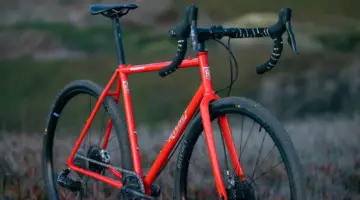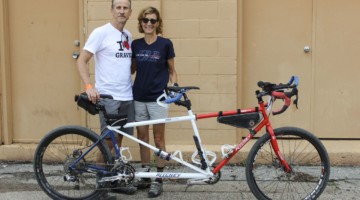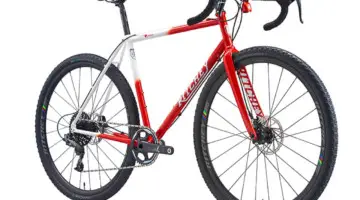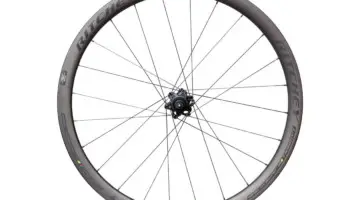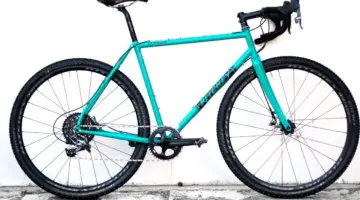NAHBS 2014 visitors may have seen a disc brake version of the Ritchey Swiss Cross bike sitting in the Ritchey booth, brazed by Tom Ritchey himself (see our review of the canti Ritchey Swiss Cross in Issue 15). Astute observers may have noticed that the bike was being displayed with a new Ritchey WCS disc brake fork with a straight, 1-1/8″ carbon steerer—a rarity in these days of tapered head tubes and steerers.
We had a chance to talk with the folks at Ritchey about this new product, and have one in hand for a full review in the near future.
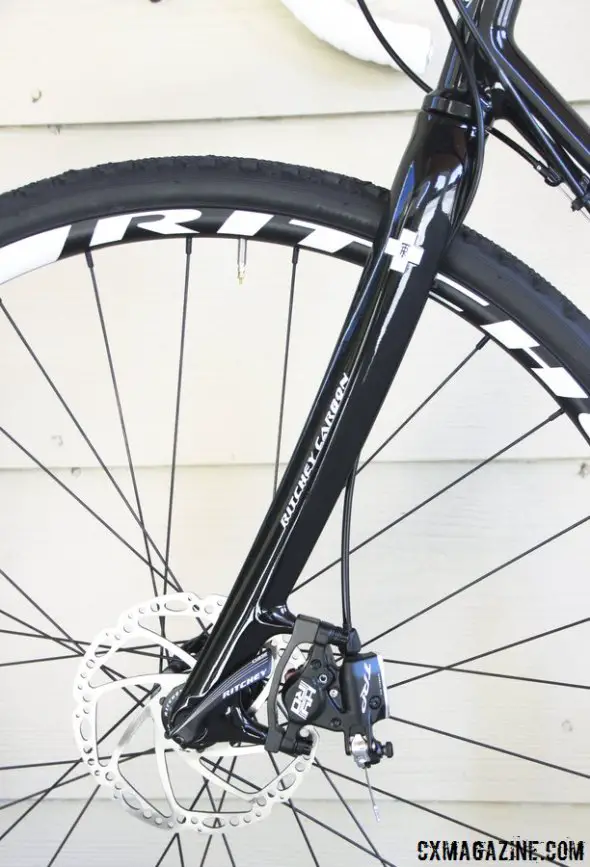
Want to add disc brakes to your older non-tapered head tube frame? Ritchey has a new WCS disc fork for you, with a 1-1/8″ straight steerer. © Cyclocross Magazine
What’s the big deal with a straight steerer? Since the return of disc brakes, nearly every fork manufacturer save Wound Up has introduced cyclocross forks for disc brakes with tapered steerers, citing the need for oversized steerers (and crowns) to past EN testing and counteract the braking forces of a disc brake. Ritchey has engineered this full carbon fork to handle a disc brake’s forces while still maintaining the weight savings, older bike compatibility and ride quality offered by a straight carbon steerer.
Why buck the trend of tapered steerers? “We feel that 1-1/8″ steerer has worked very well, for a very long time,” says Sean Coffey, Ritchey’s Global Marketing Director. “You get all your ride tuning out of the lower portion of the fork, and while you can definitely get a lot more stiffness out of a bike if you go with a larger head tube and big bearing, with ’cross bikes we feel like it’s too much.”
Long-time readers will remember our first experience with tapered steerers way back in Issue 8, in testing the original Focus Mares carbon cyclocross bike with a tapered 1-1/4″ to 1-1/8″ steerer, and we remarked that the front end and stout fork “might be overly stiff.” Our tester remarked, “As soon as I hit less stable surfaces, the front end seemed twitchy and was punishing.” Since then, manufacturers have gone even bigger, with some moving to 1-1/2″ diameter tapers, and front-end stiffness, in general, has increased. Ritchey believes for cyclocross, it’s unnecessary, and that compliance matters more.
“Tom [Ritchey] is great for talking about [the cycling industry being] on a big pendulum,” Coffey recalls. “You have aero here, superlight here, stiffness here, and the middle [according to Tom] is always the right spot.”
In developing their new Ritchey WCS Carbon Disc Cross Fork, the company also redesigned its WCS Carbon Cross fork for cantilever brakes. The new canti fork has also received a tweak in geometry, losing 5mm in axle-to-crown distance, with both the disc and canti fork now settling on the standard 395mm length. Both forks, we’re told, will retail for $449.95 $399.95, and both will weigh around 440g. Our test disc brake fork, with an uncut steerer weighed an impressive 441g, and 464g with Ritchey’s steerer plug. That’s certainly lighter and more affordable than Ritchey’s main competition.
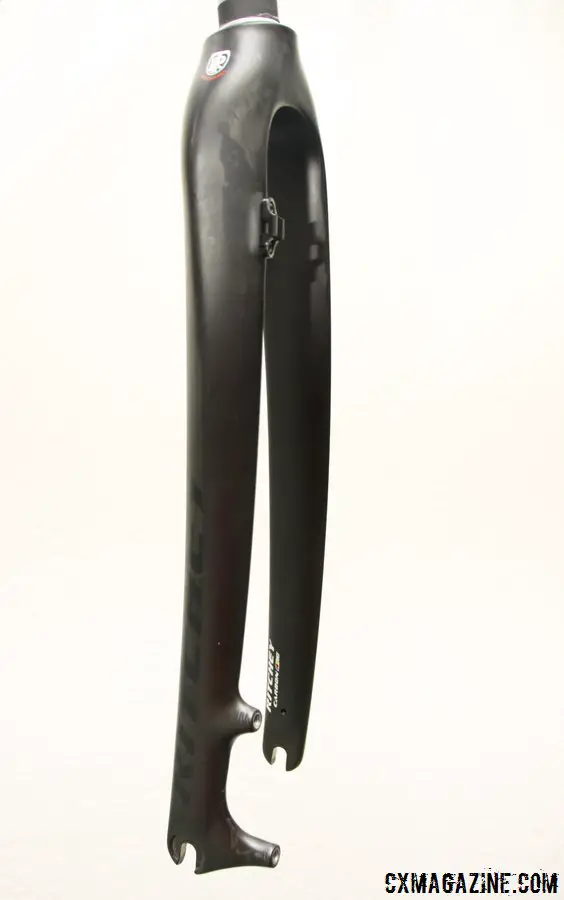
At $449, the fork beats much of the full-carbon competition, and weighs a tad less too. © Cyclocross Magazine
The straight steerer offers cyclocrossers with older bikes, or upcoming custom bikes, more options. Older bikes can now be retrofitted with front disc brakes, arguably where most of the braking power is needed, and owners of the first generation of disc brake cyclocross bikes (including Redline and Cannondale bikes from the early 2000’s) can now replace their forks with a lighter, full-carbon model.
Custom builders, especially steel and titanium builders, also have a new disc brake fork option to save customers weight and money. They don’t have to have an expensive, oversized 44mm head tube that typically weighs as much as 100g more than a standard head tube. Combined with the $100+ savings when selecting the $449 Ritchey WCS over a tapered fork, the customer can save some money and weight.
The disc fork is built with post mounts set up for 140mm rotor, and adaptors can be used to work with 160mm rotors. The fork is full carbon, including the dropouts, and both the disc and canti fork now featured an integrated crown race that is compatible with any headset featured a 45 degree tapered bearing interface. Coffey said FSA, Cane Creek and Chris King all work fine, in addition to Ritchey headsets, of course.
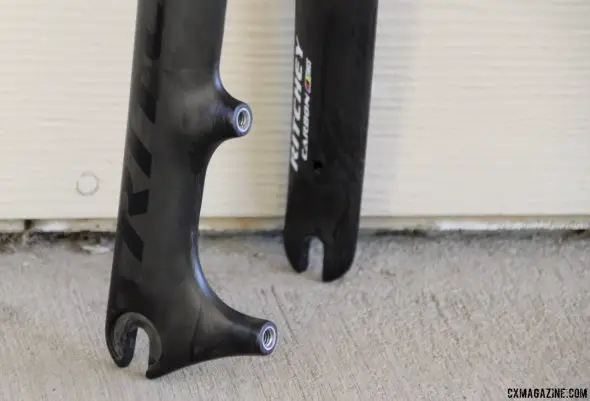
Ritchey’s fork has been in development for several years, before 160mm front rotors became the popular standard, but 140mm rotors or 160mm with an adaptor will work. © Cyclocross Magazine
The integrated crown race may be a curious feature, and while it saves a bit of weight, it also helps Ritchey avoid sharper angles for the continuous carbon fibers that run from the dropouts through the steerer. “Carbon doesn’t like making 90 degree turns,” says Coffey.
Price and weight are of course irrelevant if you don’t like the ride of the fork. If you’re a fan of stiffer-is-always-better, you probably don’t need to read further, but Tom Ritchey and the team at Ritchey describe the company as a “ride quality company” and design their forks, frames and components around this philosophy. Their new WCS disc brake cyclocross fork, along with their updated WCS cantilever cyclocross fork, are designed to offer vertical compliance for a smoother ride. Anyone who rode their last few iterations of cyclocross forks can attest to the forks’ relative compliance, with some tendency for brake chatter, but Ritchey’s Sean Coffey balks at the suggestion that Ritchey forks are chatter prone.
“I can make a bike with a straight steerer and cantilevers not chatter,” says Coffey. “It doesn’t matter where you hang a cable,” he maintains. At Cyclocross Magazine, we’ll argue that fork flex, and its ability to tighten the brakes during such flex (thus cable hanger placement matters) are major variables in fork chatter, but agree with Coffey that a comfortable, compliant fork does not mean fork chatter is unavoidable with cantilever brakes. (See our feature on cantilever brake setup and chatter in Issue 7.)
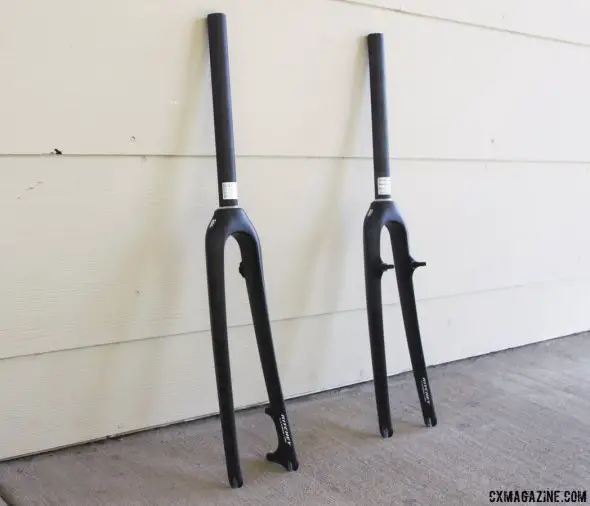
Ritchey reworked its canti fork and has a new disc fork. Both feature 1-1/8″ steerers. © Cyclocross Magazine
“It’s got a lot more to do with brake pad length and how sloppy the brakes are [than steerer diameter],” Coffey explains, and by using shorter pads and brakes that are not loose on the post, he believes a mechanic should be able to set up their cantilever brake fork to be chatter-proof, without relying on the linear pull brakes or a fork-mounted cable hanger (there isn’t a piercing for cable hanger anyway).
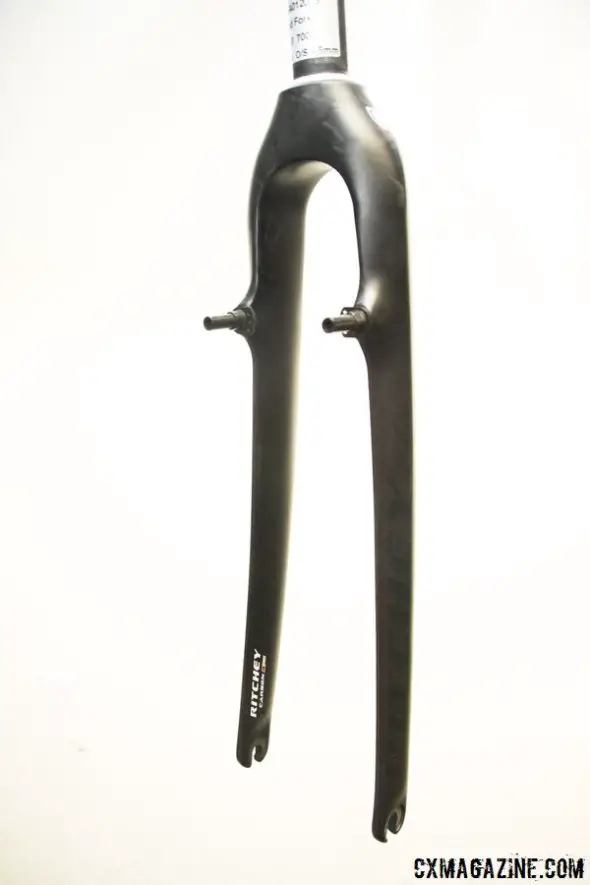
The canti fork gets a new layup, integrated bearing race, and shorter axle-to-crown. © Cyclocross Magazine
What else is new with the latest WCS Carbon Cross fork? Coffey says the fork features a modern carbon layup that’s an improvement over the previous model. “The biggest difference would be the integrated crown race allows us basically to control the fibers a little better, tune the ride quality a bit more…we’ve learned a bit more about layup since [the previous model].”
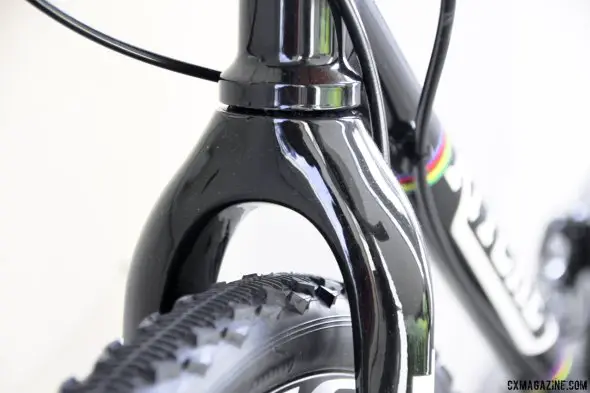
The huge tire clearance makes it a good option for fat tire and monster cross riders. © Cyclocross Magazine
The one thing that we’re really happy Ritchey kept is the extremely generous tire clearance on its cyclocross forks. On the previous cantilever model, 45c tires and narrower 29er tires fit without issue, and with a standard cyclocross tire, there was plenty of mud clearance. On the new versions of the forks, the clearance looks to be almost as good, pleasing monster crossers and fat tire gravel racers.
Stay tuned for a full review of the Ritchey WCS Carbon Disc Cross Fork.
Ritchey WCS Carbon Cross Fork Specs:
MSRP: $449.95
Weight: 441g, 464 grams with plug and uncut steerer
Rotor size: 140mm standard, 160mm with adaptor
Axle to Crown Length: 395mm
Steerer Diameter: 1-1/8″
Rake: 45mm
More Info: www.ritcheylogic.com































